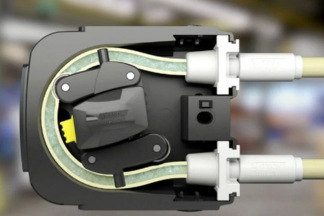What Is a Peristaltic Pump and How Does It Operate?
There are many different kinds of pumps on the market that can move clean liquids, but many of them struggle to move fluids that contain debris. The liquids that conventional pumps cannot handle can be handled by peristaltic pumps. With most pump types, including centrifugal pumps, toxic chemicals, slurry, and wastewater are all issues, but they can all be managed by peristaltic pumps thanks to their no-contact design. You can learn more about peristaltic pumps below, including what they are, how they operate, what kinds there are, how to maintain them, as well as their benefits and drawbacks.
A peristaltic pump is what?
A rotational positive displacement pump called a peristaltic pump, often referred to as a roller pump, is used to move liquids without the contents coming into touch with the pump’s internal parts. A peristaltic pump’s tubing is the only part that comes into contact with liquid moving through it from the point of intake to the point of output. Peristaltic pumps are airtight devices that are resistant to drips and leaks since fluid only passes through the pump’s tubing. This feature is crucial for these pumps because they frequently handle hazardous chemicals. Chemical compatibility tests are not required for the peristaltic pump’s seals, O-rings, valves, or other parts. Instead, just the tubing of the pump needs to be prepared to withstand the damaging effects of the chemicals being pumped
How does a peristaltic pump work?
Rotary positive displacement pumps are peristaltic pumps. This implies that instead of moving liquids back and forth like reciprocating pumps do, they do so using spinning components. Liquids are moved through flexible tubing using peristaltic pumps, which use a set of rollers sometimes known as shoes. In order to draw liquid into the pump, these rollers produce a vacuum inside the tube. A second shoe forces the liquid past the pump and out the outlet once the water has entered the tube. The cycle continues as the following roller squeezes an empty section of the tube, creating a vacuum that draws liquid in. A peristaltic pump’s flow is more consistent the more rollers it has. Pumps with only two rollers will discharge at observable intervals. The term “pulsation” refers to this change in flow.
When it comes to pumping thick liquids and liquids containing particle matter, peristaltic pumps are incredibly effective. The majority of pumps have check valves to stop backflow, which is when liquid backs up into the pump’s inlet. Peristaltic pumps have an inherent resistance to backflow due to their roller construction. These pumps only flow in one direction. Due to the rollers’ single-direction rotation, the suction they produce can only draw liquid in from the outside and not the other way around. Other pump types employ check valves to prevent backflow, however these valves are prone to clogging from debris. There are no parts that particles can stick to and cause issues because peristaltic pumps don’t require any check valves.
The amount and kind of rollers in the pump, together with the number of channels it employs, all have an impact on the design of peristaltic pumps. For instance, thick tubing needs more force to be squeezed than thin tubing, so a pump’s rollers need to be able to handle thick tubing under high-pressure situations. The kind and quantity of rollers a peristaltic pump has an impact on the uses the pump might be put to as well as the durability of the tubing.
Types of rollers in peristaltic pumps
Rollers in peristaltic pumps can be either fixed occlusion or spring loaded.
Fixed occlusion rollers
The position of fixed occlusion rollers never changes. They are in a fixed position and rotation, which results in consistent pressure on the tube. In comparison to thin tubing, thick tubing is less compatible with fixed occlusion rollers. This incompatibility is brought on by blockages, also known as occlusions, which happen in between peristaltic pump cycles. A fixed occlusion roller exerts less pressure on tubing that is thicker. Because of the increased occlusion caused by this, the tubing’s lifespan is shortened. Make sure the tubing thickness you choose is compatible with your pump to avoid this issue.
Spring-loaded rollers
As the name implies, spring-loaded rollers are moved by a spring. The force that these rollers provide to the tubing is proportional to the thickness of the tubing. No of the size or thickness of the tubing, spring-loaded rollers maintain a consistent pressure. High-pressure pumps need thick tubing, hence hose peristaltic pumps tend to have more spring-loaded rollers than their tube counterparts.
Types of peristaltic pumps The two forms of peristaltic pumps are hose pumps and tube pumps. Both types of pumps use rollers to move fluid through tubes, but they vary in terms of their capacity for pressure, the type of tubing they use, and how well they dissipate heat.
Peristaltic hose pumps
Since hose peristaltic pumps have thick, reinforced tubes that carry fluids through the pump, they are employed in industrial settings. Hose pumps are able to work at pressures that are up to four times higher than those of tube pumps because of their thick tubes. Additionally, hose peristaltic pumps develop clogs less frequently than their tube counterparts due to higher operating pressure. Hose pumps, as opposed to tube pumps, have lubricant-filled casings that guard against overheating and abrasion from roller friction.
Tube peristaltic pumps
Liquid is moved by tube peristaltic pumps at lower pressures than by hose pumps. The rollers in a tube roller pump squeeze a thin, non-reinforced tube rather than a thick one. Anywhere from two to twelve rollers might be found inside a tube pump. These rollers are evenly spaced apart from one another. As an illustration, two rollers will be 180 degrees apart, whereas four rollers will be 90 degrees apart. Fluid is discharged from pumps with two rollers less often than those with more. However, because there are more tube blockages with more rollers, pumps with more of them will wear down more quickly than ones with fewer. These low-pressure pumps are most frequently used for chemical metering and medical liquids.
Peristaltic pump maintenance
Because the pump components do not come into touch with the liquid being circulated, peristaltic pumps are among the lowest maintenance pump kinds. The monitoring and replacement of tubing are the main peristaltic pump maintenance procedures. The tube deteriorates with time as a result of the constant pressure applied by roller pumps. The pump’s feed rate decreases as the tubing deteriorates. The pump uses more energy when this happens than when the tubing is in ideal condition. Tubing needs to be changed when it starts to impair the pump’s operation.
Peristaltic pump tubing is graded based on how long it can operate at maximum tension. The user of a peristaltic pump should keep track of how many hours the tubing has been used. The tube needs to be replaced when it exceeds the recommended lifespan. The pump that is being used with the tubing also has an impact on its lifespan. Make sure the tubing’s size and thickness are appropriate for the pump you are using. The rollers may exert too much pressure on the tubing if it is too thin for a particular pump and breaks. The rollers may not exert enough pressure and result in damaging system occlusion if the tubing is excessively thick.
How to clean a peristaltic pump
Peristaltic pumps’ tubing needs to be cleaned more regularly than the actual pump because they don’t come into contact with the fluids they push. Cleanings must be done frequently if sticky substances are used with the pump to make sure the tube is kept clear of impediments. Simply substitute soap for the regular fluid in a peristaltic pump, then rinse the tubing with a sanitising solution like IPA. Before resuming regular operations, let the tube dry. Even while peristaltic pumps’ outside surfaces may not get dirty frequently, it is nevertheless a good idea to regularly wipe them down with an IPA solution. Switch off the pump and unhook the power source before wiping these areas. Before turning the power back on, let the pump dry.
What are peristaltic pumps used for?
Peristaltic pumps are used in a wide variety of applications. The best feature of these pumps is their ability to keep chemicals and liquids strictly in the tube.
When to use a peristaltic pump:
1.Transporting hemoglobin for dialysis
2.Surgical applications
3.Water treatment dosing (depending on the chemical used)
4.Chlorine for a private well
5.Liquid phosphate for scale control
6.A flocculant (depending on the type of water treatment)
7.Dosing vitamins into animal feed
8.Agriculture
Uses for a peristaltic pump include any application where you want to ensure you have no-cross contamination of your nutrient, chemical, or even blood in the case of dialysis.
How much do peristaltic pumps cost?
You should budget between 20,560 and 82,242 for a commercial peristaltic pump. Compared to other types of pumps, these pumps have a greater starting cost. The only necessary maintenance, however, is the very cheap operation of tube replacement.
How long do peristaltic pumps last?
Peristaltic pump motors have a long lifespan; some of them can last up to 10,000 hours. Peristaltic pumps have a lengthy lifespan in large part because of its no-contact pumping system. The tubing sustains the majority of the damage from particles and debris in liquids instead than the pump when abrasive liquids are present.
Advantages of peristaltic pumps
Peristaltic pumps are useful for many applications because of their many advantages over other pumps.
Leak-resistant
Capable of running dry for extended periods
Can handle very viscous and rough fluids (up to 60,000 cps)
Does not allow contamination
Resistant to backflow
Useful in a variety of applications
Low maintenance costs
Disadvantages of peristaltic pumps
While peristaltic pumps are excellent for many applications, they do possess a few disadvantages when compared to other pump types.
High initial cost
Tubing degrades with each use
Higher power usage than most pumps
Causes pulsation in flowrate

